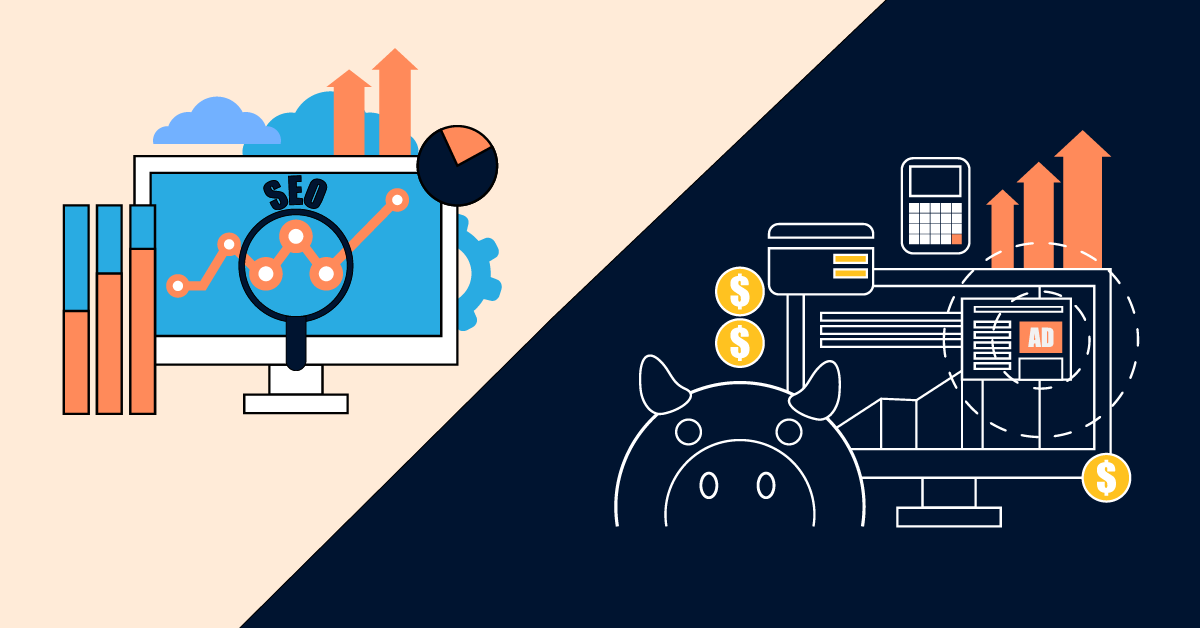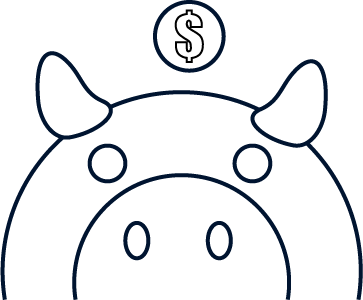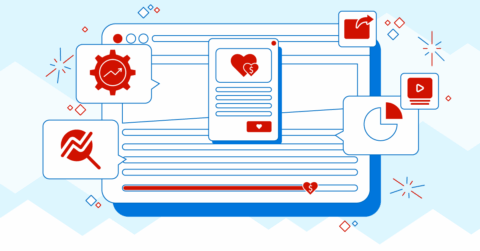
Lúgh Studio’s Ultimate Guide To Organic vs. Paid Marketing
07/28/22
digital design
Many businesses will eventually face the issue of “organic vs. paid.” Choosing which one to focus on is important, and it’s a decision that can have big consequences for the things you prioritize at your business.
Today we are diving deep into the question of “organic vs. paid.” We’ll show you why they are so different and how you can decide which (or both) to use. We will also give you some tips on optimizing your strategy overall.
Download Your PDF Version Of This Guide Here
- Difference between organic and paid
- Why it’s important to know the difference between the two
- Organic vs. paid: which one should you choose
- Strategies for organic
- Strategies for paid
- Resources for learning more
…
Difference Between Organic and Paid
While there are multiple differences between the two, here is a useful way to look at both of them:
- Organic marketing is a (mostly) free way to implement content to generate more traffic to your site over time
- Paid marketing is a way to implement paid ads to generate more targeted traffic to your website relatively quickly
While both strategies have a number of different elements to them, organic is mostly associated with content marketing, while paid is all about paid ads on different platforms.
Why It’s Important to Know the Difference Between the Two
While many businesses will use both strategies, and they can complement each other, the strategy you focus on will have very different implications for how you run your business. That’s because organic and paid marketing are often very different in what they require of a company. This difference has one big implication: the resources and tools (and skill sets) you need to invest in will vary quite a lot depending on which strategy you choose to focus on.

This isn’t to say that one is better than the other. In fact, both have a unique set of benefits (which we will discuss later). Still, depending on which one you choose to focus on, it will have big implications for your overall business plan. This includes everything from who you hire, to the weekly tasks you assign your team, to the types of clients you work with.
With that in mind, let’s dive into more specifics of organic vs. paid. Both organic and paid marketing methods can be effective, but which one you choose to prioritize depends on a number of factors.
Organic vs. Paid: Which One Should You Choose?
It should be clear now that both organic and paid marketing have their benefits. Most businesses have a certain mix of the two, and both can work wonders in raising awareness of your business, generating leads, and converting them into customers. Still, many businesses will pour most of their resources into one or the other.
Organic is better if:
1) You don’t have a big budget
If there is one thing that most smaller companies or agencies have in common, it’s that they don’t spend so much money on paid ads. This makes sense, as ads can be expensive and are no guarantee of return of investment.
That’s why it’s often a good idea to focus on organic marketing if your budget is smaller. This applies to people just getting started with their company or agencies that don’t yet have too many clients. Margins are thin, and extra cash for ads might not be easy to come by.
2) There isn’t that much competition in your niche
Much of organic marketing is centered on creating great content. This is content that educates or entertains your audience, and eventually builds up a relationship with people so that they buy from you.
While this can be quite effective in modern marketing, certain niches are simply more competitive than others. In this case it can take a ton of time to get results from content marketing. Just think about opening a phone store: do you really think your blog post reviewing an iPhone is going to beat out the thousands of articles dealing with this exact topic? That’s why organic marketing makes sense especially for companies in less competitive niches.
3) You don’t need results fast
Following our last point, organic marketing takes time. It’s a long game for companies that can afford to wait, and often takes time before effects start to set in. That’s why organic is a better fit for a company that has time for results.
Paid is better if:
1) You have the money to spend
It’s an obvious point to make, but paid marketing requires money. And quite often more than you expect. That’s because your ads probably aren’t going to perform on your first try. There are going to be edits that you need to make, iterations that you need to implement. To get the results you are looking for from paid ads, a certain amount of experimentation is needed.

All of this requires cash. Still, because of how effective ads can be, it’s money well-spent if you can get them to work. That’s why paid marketing is well-suited to companies that have the budget for it. If you have great margins and have money saved up, ads can be a great opportunity to pour money back into the company.
2) You already have a proven funnel set up
Certain companies have a good read on exactly how valuable a new lead is. They know what sort of message somebody needs to see in order to become a lead, understand how many leads they need to generate to make a customer, and know how much money they can afford to spend in order to acquire a new customer. This is all part of their marketing funnel.
In the case that a company understands their funnel inside and out, paid ads are likely a good choice. That’s because they know exactly how much money they can afford to spend on ads: really any price that is lower than the average lifetime value of a customer.
3) You need results as soon as possible
While organic marketing should be an element of most business plans, we’ve seen that it takes time. This is time that not all businesses actually have.
Think about it. Maybe a company wants to test the response to a new product before actually launching. Maybe they need more email subscribers quickly. Perhaps they have an obligation to generate a certain amount of leads for their client before a specified date, and are short on time. These are all situations in which they can’t afford to wait. The quicker results that paid advertising achieves is therefore a great match (assuming they have the budget for it).
Strategies for Organic
Provide as much value as possible
Value is really the name of the game when it comes to organic marketing. You want people to think of your company and free content as so helpful that they can’t really compare it to any other source. This type of ”10x content” is a tall order and admittedly isn’t something that comes easily. Still, it’s a goal worth pursuing. Even if your content doesn’t reach the “10x” level, your finished product is likely going to be better than most of your competitors.
Keyword research for proven content
Because organic marketing is based on content that provides value, you need to make sure the content you are making is actually in line with what your potential customer wants. You do this by implementing keyword research. We have written about this numerous times, so be sure to check out our post on the topic.

In addition, for a tool that will help you with your own keyword research, check out Ahrefs. This is one of the leading solutions in the market and is used by big brands all across the world.
Look at what your competitors are doing
Who are the most successful companies in your industry? Which brands in your niche are the ones that seem to get all the customers? If you know the answer to these questions, it’s worth checking out the kind of content they make. Their success is coming from somewhere!
Are they focusing mostly on how-to tutorials? Is their content more entertaining? Do they do deep dives into topics, or is their content shorter and more easily digested? Answering these questions will give you a good roadmap for strategies you can implement in your own content. Check out our guide to competitor research for more actionable advice.
Strategies for Paid
Use content that performs well in organic as paid
As we’ve discussed, many companies use a mixture of organic and paid marketing. This means that companies that have a certain amount of budget set aside for ads also have a fair amount of content on their site. This is good news, as it means that they already have data on what works.
A simple way for a business to get this insight is to check out their Google Analytics. By looking at stats like “total traffic” and “time spent on page” of their various pieces of content, they will understand which pieces of their content most resonate with their audience.
Learn from ads you see from other companies
Is there a Facebook ad that you seem to find everywhere? This is a sign that the ad is performing well — otherwise the company wouldn’t be running it. Is there a Google ad with a creative headline that convinces you to click through? This is an idea you can implement later with your own ads.

The point is, with how many companies are using paid ads, there is always an opportunity to learn something new. So pay attention to the ads that you see. Make a note of the ones that grab your attention. Odds are they are grabbing the attention of other people too, and they likely have elements that you could successfully apply to your own ads!
Make your ads look like free content
The clickthrough rates of organic results is usually much higher than ads. The reason why is very simple: people just don’t like ads. That’s why it’s worth your time to make your ads look as close to “organic” as possible. Check out this guide by Microsoft if you want to learn specific tactics for making more engaging ads.
Of course, it’s important to remember that you aren’t trying to deceive people. Rather, you are simply creating an experience of them interacting with your ad that they actually enjoy!
Test as much as possible
As we point out in our ultimate guide to PPC ads, the golden rule to getting results from paid advertising is testing as much as possible. The fact is, you are hardly ever going to be successful on your first try. And even if you are, there is always something you can change to get even better results.
That’s why split testing is so essential to successful paid marketing. Here are some things you might consider testing:
- Image / creative: Depending on the platform you are advertising on, the image is the first thing somebody will see. For this reason, a split test here can often have the most immediate impact.
- Headline: You need a headline that provokes curiosity but also promises enough of a benefit to get somebody to click. Even changing just one word here can make a difference.
- Call to action: What are you asking somebody to do? Watching a video? Downloading their free brochure? Filling out a form? Regardless, the CTA is one of the most influential elements of an ad.
Resources For Learning More
Now that you understand the difference between organic vs. paid, you likely have a good idea of which one you want to focus on. For the best results possible, it’s important to continuously educate yourself about the field. With that in mind, here is a list of a few great resources that can help you with both organic and paid.

Organic
- Content Marketing Institute. Your resource for everything related to content marketing.
- Ahrefs. Everything you need to get more traffic to your website + world-class training on keyword research.
Paid
- Google Ads. Resources and courses to improve your skills in making profitable Google ads.
- Facebook Ads. Everything you need to run engaging and effective ads on one of social media’s biggest ad patforms.
Conclusion
Both organic marketing and paid ads can have a great impact for your company. Regardless of which one you choose, though, it’s important to constantly learn and experiment as much as possible.
Download Your PDF Version Of This Guide Here
We hope you enjoyed our ultimate guide to organic vs paid. Let us know if you have any questions and good luck with your marketing!









